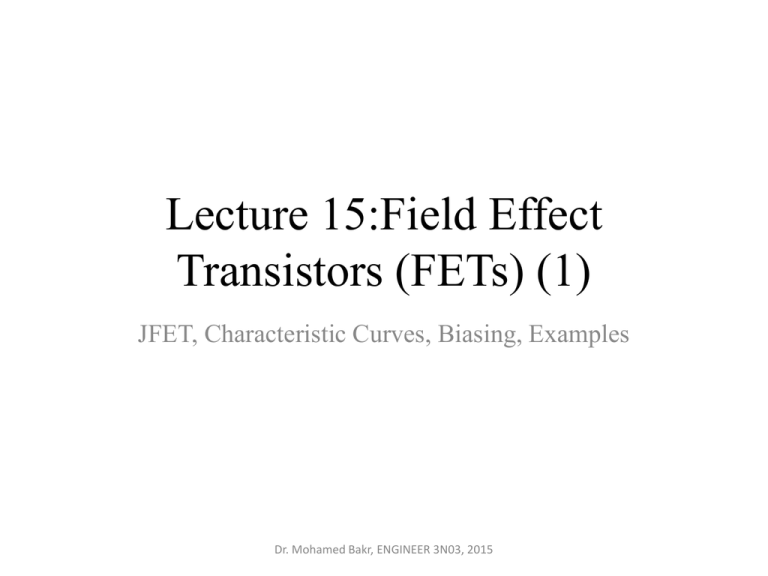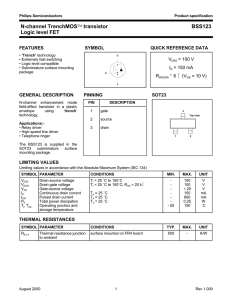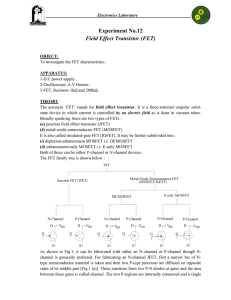Document
advertisement

Lecture 15:Field Effect Transistors (FETs) (1) JFET, Characteristic Curves, Biasing, Examples Dr. Mohamed Bakr, ENGINEER 3N03, 2015 FET The idea for a field-effect transistor (FET) was first proposed by Julius Lilienthal, a physicist and inventor. In 1930 he was granted a U.S. patent for the device. His ideas were later refined and developed into the FET. Materials were not available at the time to build his device. A practical FET was not constructed until the 1950’s. Today FETs are the most widely used components in integrated circuits. Dr. Mohamed Bakr, ENGINEER 3N03, 2015 JFET The JFET (or Junction Field Effect Transistor) is a normally ON device. For the n-channel device illustrated, when the drain is positive with respect to the source and there is no gate-source voltage, there is current in the channel. When a negative gate voltage is applied to the FET, the electric field causes the channel to narrow, which in turn causes current to decrease. RD D n G VGG – + Dr. Mohamed Bakr, ENGINEER 3N03, 2015 + p p n S – VDD JFET Operation Dr. Mohamed Bakr, ENGINEER 3N03, 2015 JFET Circuit Symbol There are two types of JFETs: n-channel and p-channel. The dc voltages are opposite polarities for each type. The symbol for an n-channel JFET is shown, along with the proper polarities of the applied dc voltages. For an n-channel device, the gate is always operated with a negative (or zero) voltage with respect to the source. RD + VDD – VGG + We will focus on n-channel JFET Dr. Mohamed Bakr, ENGINEER 3N03, 2015 – Drain Characteristic Curves There are three regions as illustrated for the case when VGS = 0 V. Between A and B is the Ohmic region, where current and voltage are related by Ohm’s law. ID B IDSS C From B to C is the active (or constant-current) region where current is essentially independent of VDS. Beyond C is the breakdown region. Operation here can damage the FET. A 0 VP Dr. Mohamed Bakr, ENGINEER 3N03, 2015 VDS Characteristic Curves (Cont’d) When VGS is set to different values, the relationship between VDS and ID develops a family of characteristic curves for the device. ID An n-channel characteristic is illustrated here. Notice that Vp is positive and has the same magnitude as VGS(off). IDSS VGS = 0 VGS = –1 V VGS = –2 V VGS = –3 V VP = +5 V Dr. Mohamed Bakr, ENGINEER 3N03, 2015 VGS = – 4 V VGS = VGS(of f) = –5 V VDS Transconductance Curve A plot of VGS to ID is called the transfer or transconductance curve. The transfer curve is a is a plot of the output current (ID) to the input voltage (VGS). ID The transfer curve is based on the equation VGS I D I DSS 1 V GS(off) IDSS 2 By substitution, you can find other points on the curve for plotting the universal curve. –VGS VGS(off) Dr. Mohamed Bakr, ENGINEER 3N03, 2015 0 Transconductance The transconductance is the ratio of a change in output current (DID) to a change in the input voltage (DVGS). This definition is g m DI D DVGS The following approximate formula is useful for calculating gm if you know gm0. ID IDSS VGS g m g m0 1 V GS(off) The value of gm0 can be found from gm0 2 I DSS VGS(off) DID DVGS –VGS VGS(off) Dr. Mohamed Bakr, ENGINEER 3N03, 2015 0 Biasing of a JFET Self-bias is simple and effective, so it is the most common biasing method for JFETs. With self bias, the gate is +VDD essentially at 0 V. An n-channel JFET is illustrated. The current in RS develops the necessary reverse bias that forces the gate to be less than the source. RD VG = 0 V + RG Dr. Mohamed Bakr, ENGINEER 3N03, 2015 RS – IS Voltage Divider Biasing Voltage-divider biasing is a combination of a voltage-divider and a source resistor to keep the source more positive than +VDD the gate. VG is set by the voltage-divider and is independent of VS. VS must be larger than VG in order to maintain the gate at a negative voltage with respect to the source. Voltage-divider bias helps stabilize the bias for variations between transistors. Dr. Mohamed Bakr, ENGINEER 3N03, 2015 RD R1 ID VG VS R2 IS RS Current Source Biasing An even more stable form of bias is current-source bias. The current-source can be either a BJT or another FET. With current-source biasing, the drain current is essentially independent of VGS. In this circuit Q2 serves as a current source for Q1. An advantage to this particular circuit is that the output can be adjusted (using RS2) for 0 V DC. +VDD +15 V Q1 2N5458 RG 1.0 MW Offset control RS1 470 W RS2 1.0 kW Q2 2N5458 RS3 1.0 kW VSS 15 V Dr. Mohamed Bakr, ENGINEER 3N03, 2015 Vout





